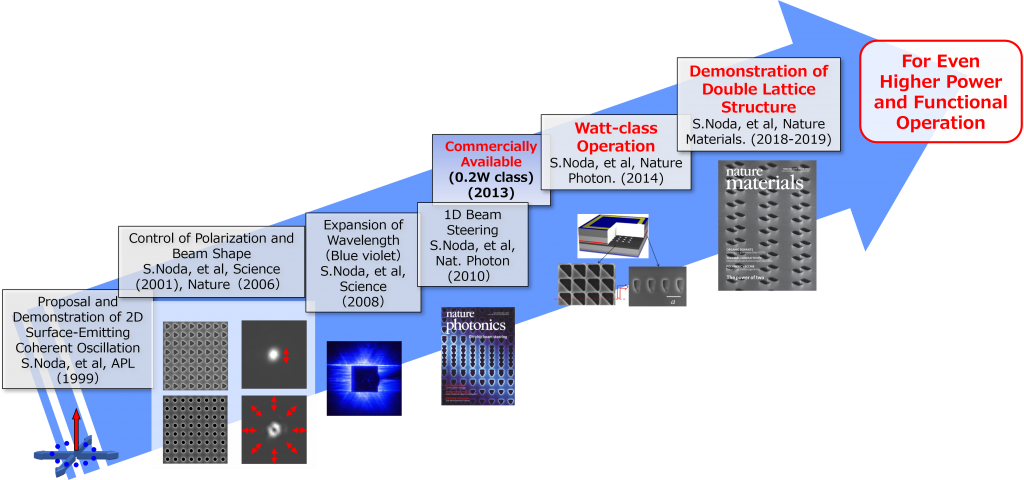Our History
We invented Photonic-Crystal Surface-Emitting Laser (PCSEL) in 1999. The latest PCSEL technologies are updated daily at our COE.
In 1999, we proposed a concept of PCSEL, which operates at a singularity point (Γ) of their two-dimensional (2D) photonic crystal, whose lattice (e.g., square, triangular) consists of two types of materials with a large refractive index contrast (such as air/semiconductor). In this high-contrast lattice, not only first-order (i.e., fundamental) Bloch waves, but also higher-order Bloch waves are coupled with each other to form a stable 2D standing wave (or resonant mode.)
PCSELs are different from 2D distributed feedback (DFB) lasers, whose periodic structures have a smaller refractive index contrast such as semiconductor/semiconductor (namely, all semiconductor) and, thus, cannot facilitate coupling between all but the fundamental waves; this limitation of coupling prevents coherent 2D resonance of (most important) transverse-electric (TE) modes in square-lattice structures. This means PCSELs consisting of “all-semiconductor” does not work.
Due to the nature of the Γ-point, emission can be obtained from the surface of the photonic crystal; we named the laser a PCSEL to reflect this property. Since then, we have developed the basic operating principles of photonic-crystal lasers and a variety of new functionalities, including polarization and beam pattern control, blue-violet wavelength emission using wide-band-gap materials, beam steering, and watt-class and 10 Watt-class (and even) higher-power operation with a high beam quality. Recently, we proposed and demonstrated an even newer type of PCSEL that possesses a (dually) modulated photonic crystal structure; this new type of laser enables the on-demand, two-dimensional control of beam diffraction while simultaneously preserving two-dimensional resonance.

In recognition of innovative research on Photonic Crystals and Photonic-Crystal Surface-Emitting Lasers, we have received various awards, including the IBM Science Award (2000), the Japan Society of Applied Physics Achievement Award on Quantum Electronics (2005), Optical Society of America Joseph Fraunhofer Award / Robert M. Burley Prize (2006), 1st the Japan Society of Applied Physics Fellow (2007), the Commendation for Science and Technology by the Minister of Education, Culture, Sports, Science and Technology (2009), the IEEE Nanotechnology Pioneer Award (2009), the Reo-Esaki Award (2009), Medal with Purple Ribbon (2014), the Japan Society of Applied Physics Outstanding Achievement Award (2015), Fellow of the Laser Society of Japan (2017), and Taizan Award of Institute of Laser Technology (2018) and MOC (Microoptics Conference) Award (2019), the Japan Academy Prize (2022).
At the COE of Kyoto University, we are developing our own technology in cooperation with various partner companies including users and manufacturers of lasers, deploying it to various wavelengths, and implementing advanced functionalities. These companies will form the basis of the advanced PCSEL supply chain.